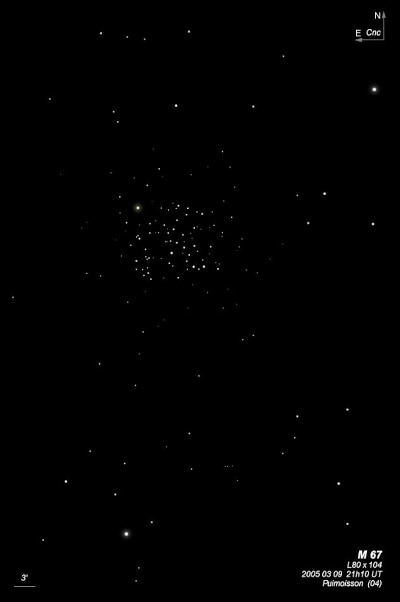
Johann Gottfried Koehler (discoverer of M50 and M60) discovered M67 = NGC 2682 = h531 before 1779 and recorded "A rather conspicuous nebula in elongated figure, near Alpha of Cancer." Messier independently discovered it on 6 Apr 1780 and logged "Cluster of small stars with nebulosity, below the southern claw of Cancer. The position determined from the star Alpha [Cancri]." William Herschel first observed the cluster on 26 Mar 1783 using his 6-inch and simply noted a "cluster of stars." With his 18-inch in 1784 he described "a most beautiful cluster of stars; not less than 200 in view."
M67 is an old open cluster with age 3-4 billion years (Sue French states 2.6 billion years in March 2009 S&T while Astronomy mentions 3.2 billion in the Apr 2012 issue. The position given in Lynga #5, Sky Catalogue 2000, NGC 2000 and Deep Sky Field Guide (first version) is about 1.0 min of RA too far west.
300/350mm - 13.1" (12/22/84): about 100 stars mag 10-15 in 15' diameter, very rich and impressive cluster.
13.1" (3/24/84): beautiful at 88x with over 75 stars resolved at this magnification.
400/500mm - 17.5" at 140x about 200 stars mag 10-14 in a 15' diameter. Includes several rich subgroups including one on the south edge near three brighter mag 10 stars. The brightest star mag 7.8 SAO 98178 is just off the NE edge.
Notes by Steve Gottlieb